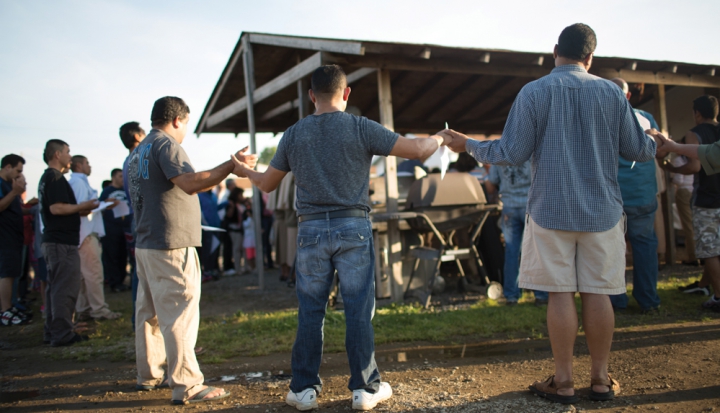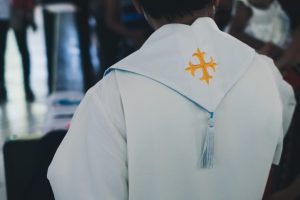For Iris Fernandez, faith is a priority. A Puerto Rican lay ecclesial minister in Norwich, Connecticut, Fernandez works full-time for the state. But her off-work hours are spent pursuing her passion for her faith—and that comes bubbling to the surface easily.
Every Tuesday Fernandez leads a prayer group of 20–30 people. She goes to the homes of shut-ins to pray the rosary. She and her husband have led marriage preparation courses for 20 years. “I feel like I am always living at the church. The days I don’t go, I miss it,” Fernandez says. “I help to guide people in our parish: lectors, eucharistic ministers, catechists—and we have to fill in when needed—but mostly you help people accomplish what they are called to do.”
Fernandez was trained in a diocesan program for lay ecclesial ministers. For five years she traveled to a local seminary to learn scripture, theology, and leadership. “The diocese doesn’t have the program any longer,” she says. “But that doesn’t mean there are not other ministers. They just haven’t got the training.”
A critical moment
After the Second Vatican Council, lay ministry took off in the United States. “Many of these [lay] leaders were former religious and priests; others had been in houses of formation,” explains Hosffman Ospino, an associate professor of Hispanic ministry and religious education at Boston College. “Many were highly educated. As professionals, they were by and large middle class. Their parents or grandparents had broken through the socioeconomic barriers.”
But the situation of Latinos preparing for lay ministry today is quite different.
A study released this spring by the Center for Applied Research in the Apostolate (CARA) at Georgetown University showed that Latinos make up more than half (52 percent) of all participants in lay ministry formation programs, but are disproportionately enrolled in certificate programs, where they make up 65 percent of participants. They make up only 15 percent of students enrolled in degree programs. In contrast, white Americans make up 67 percent of degree candidates.
This disproportionate representation reflects a reality that dioceses across the United States are grappling with today: how to effectively train and empower today’s Latino youth to be tomorrow’s church leaders.
“Today, most Hispanic lay ecclesial ministers are immigrants. Many are likely the first in their families to go to college,” says Ospino. “Most Hispanic lay ecclesial ministers are not coming from middle- and upper-class families.”
Marti Jewell, associate professor of pastoral theology at the Neuhoff School of Ministry at the University of Dallas, says nearly half of her students have been Hispanic. “There are many who do not have the money for a degree program,” she explains. “So they go into certificate programs, which give them a lot of what they need.” She sees a need for degree programs, to be sure, but the bottom line, she says, is that the church needs more lay ecclesial ministers as the church grows increasingly Latino. “It is critical the bishops find the money to get more Latino lay leaders into degree programs,” she says.
The reality, Ospino says, is that more than half of Catholics in the United States under age 18 are Latino. If the church doesn’t find effective ways to minister to and retain them, Ospino says it’s “last one out, shut off the lights” time. Lay ministry formation programs have potential to be that means of outreach—but dioceses are discovering there’s no one-size-fits-all approach.
Listening is key
Right now, the Catholic Church in the United States is engaged in one of its more remarkable and distinctive events: The Fifth National Encuentro of Hispanic/Latino Ministry (V Encuentro). It is one of the few genuinely grassroots, bottom-up, ecclesial expressions in the country’s historically heavily clericalized Catholic Church. For months, starting at the local level, Latino Catholics have been meeting to assess where they are as a church and speak to their aspirations.
“Hispanic people are speaking with confidence, and our bishops are listening. That constitutes an amazing exercise of ecclesial interaction,” says Ospino, who serves on the national leadership team supporting the process of V Encuentro.
San Diego Bishop Robert McElroy speaks about the programs his diocese has for training lay ecclesial ministers, both in the Anglo and Hispanic communities. “In forming the leadership for lay ministry in the Diocese of San Diego in the Hispanic community, it is crucial to raise the level of theological and pedagogical knowledge among our leaders,” McElroy says. “Such a widespread increase of theological knowledge among our leadership in parishes would enable them to more effectively orient the vitality of popular religious celebrations and the strong tradition of faith and prayer in the home to authentic and substantive growth in the gospel and the teachings of the church.”
Such theological knowledge could also help inoculate Latino teens from the false dichotomy between faith and science, which leads many to abandon their faith in middle and high school, McElroy says.
But the bishop also thinks it is equally important to recognize the immense and pivotal wisdom, commitment, and energy among those with little education but great leadership capacity who propel faith and ecclesial participation in so many of our parishes. “I am constantly reminded of and amazed by this more fundamental wisdom in our myriad small parish-based groups,” he says.
Challenges vary
From the Northeast to the Southwest, challenges vary for Latinos interested in lay ministry. Bishop McElroy says formal programs aren’t always the best fit due to cost and participants’ education levels. “For our undocumented leaders, this is magnified tenfold,” he says. “When I first arrived in San Diego, I proposed that we use the religious education conference in Los Angeles, which I consider to be the best in the country, as a major element for our formation of leaders.”
McElroy says his staff had to explain to him that undocumented leaders in San Diego could never go to Los Angeles because they have to pass through the border control checkpoint in northern San Diego County, risking deportation. “It reminded me of the fact that the undocumented in border dioceses like ours must always remember that they live within a large prison of checkpoints on many levels,” he says.
Ospino credits some parishes and dioceses with superb outreach, especially those that include Latinos in all major pastoral planning. But other dioceses have done little to address the needs of the growing Latino population. “We have to do much better, especially in our youth ministry and catechetical programs, as well as in our Catholic schools,” he says.
Many young Latinos really want to stay in the church and drink from the wells of the Catholic tradition, Ospino says. “All one has to do is visit a Hispanic youth group or participate in a major gathering of young Hispanics to confirm this. For them, faith and culture go hand in hand. Many inherited a cultural Catholicism from their parents that awaits to be mined and strengthened. It worries me that some pastoral leaders are too critical of this ‘cultural Catholicism’ to the point of almost dismissing it, which seems to me a poor pastoral practice. Instead, it should be treated as a great starting point for ministry.”
Training tomorrow’s leaders
In 2012 Catholic Extension began a new initiative to train Latino lay ecclesial ministers. The group offers three-year grants to poorer dioceses that cover 62.5 percent of the salaries and benefits of Latino leaders engaged in new areas of ministry. The grants are also used to provide continuing education for lay leaders at Boston College, the University of Santa Clara, and the Mexican American Catholic College in San Antonio.
“Each diocese and its pastoral situation is unique,” says Joe Boland, vice president for mission at Catholic Extension. “However, what has been consistent is the real impact these new Hispanic leaders have had in their dioceses by creating new ministries and calling forth and training other leaders from their communities.” He says the group has funded 50 new leaders in 37 different dioceses, and they are raising money to support 50 more such leaders in the years ahead.
In southwest Iowa, the Diocese of Des Moines was able to hire Jessica Maciel, who works with some 32 people around the diocese to help support youth and young adult ministry among Latinos. At their diocesan encuentro this spring, she was thrilled that 80 young Latinos were present, which is a larger contingent than many major metropolitan archdioceses were able to draw at their archdiocesan encuentros. In Maciel’s diocese, more than half of the Catholics under the age of 18 are Latino, so successfully reaching out to them will determine the future of the local church.
Boston College’s Ospino has worked with some of the students funded by the Catholic Extension leadership grants. The initiative models what dioceses, parishes, and organizations throughout the country should be doing to “empower a new generation of Hispanic pastoral agents as well as to contribute to the renewal of leadership structures in our church,” he says.
Indeed, V Encuentro may be modeling that renewal of leadership structures precisely because it is lay-led and specifically Hispanic. “Dioceses and parishes should not develop ‘culturally neutral’ initiatives and then try to figure out how these apply to Hispanics,” Ospino says. “This is a time in which we need the awareness and engagement of Hispanics to be at the forefront of every conversation about pastoral planning, catechesis, religious education, vocations, and other areas of church life. Hispanics cannot be treated as an afterthought.”
Striking a balance
Presentation of the Blessed Virgin Mary Sister Rita Menart has administered a faith formation program in the Archdiocese of Dubuque, Iowa in recent years. Menart spent more than a decade in Latin America before coming to Iowa where she was hired as a part-time counselor and part-time director of Hispanic ministry. “The goal of the formation program is to help people who want to deepen their faith—the goal is not to form leaders, although we hope that may happen,” she says.
Ministry is often about striking a balance. Menart knew that many of the people she hoped would enroll had jobs that require them to work on the weekend. “I insisted on a six-Saturday commitment. I did not want to ask for too many Saturdays, but formation requires time,” she explains. Twenty-one people completed her formation program for Spanish speakers. “We are hoping to develop the program. Many of the people are already active in their parish,” she says.
Menart also had to grapple with sociocultural realities. The lay formation program did not inquire into anyone’s immigration status. She notes that Catholic Charities in the archdiocese already has three immigration lawyers “and they are looking to hire a fourth.”
She also knew that some of the people active in their parishes cannot read or write. “That was not a requirement for our program. I believe that people of all levels of education have valuable insights and wisdom to offer the Body of Christ,” Menart says. “I think it is important to offer different levels of training, degrees, and certification, because the time and abilities needed for each level are different and each person in the community has different amounts of time and abilities they can give. The different levels of commitment in the different training programs allow more people to participate in the conversation of who God is and to grow through the interchange of ideas.”
Bill Mulcahey, an Irish American Bostonian, worked at a university in Ecuador, then in Nicaragua, before ending up “in of all places, Cedar Rapids, Iowa,” where he became a campus minister at Mount Mercy University. He works with lay formation programs in the Archdiocese of Dubuque.
“Latinos have something wonderful to offer the American church about who God is,” he says. “It is not so much about transforming society, the way liberation theology suggested, but about a playful God, a God who is a part of the family and family life, not just a God of the individual. We need to be open to a different way of looking at God, and Latinos bring that.”
Looking ahead
Mulcahey says he sometimes wonders what this ministry means for the future of Catholicism in the United States. “What is the aim of Hispanic lay ecclesial ministry? What is its purpose?” he asks. “When I raise the question: ‘What do we want to do in our Hispanic lay ministry attempts?’ the ‘we’ is problematic to me. I am an Anglo. The majority of us are. What do I know of this community’s experience? Fine, I lived and worked in Latin America. I tried to inculturate into the various expressions of their societies. Do I want that to happen to U.S. Hispanic Catholics?” But, he sees great hope in the Latino presence in the U.S. church. “Their faith is alive,” he says.
If there is a common cultural denominator—and source of hope—it is this: Latinos of all stripes bring a faith that has always been rooted in family life, and, like Jews in the diaspora, such a family-rooted faith can survive in many difficult circumstances. The clergy-dominated ecclesial life of the U.S. church is giving way to a different, less clericalized, more popular expression of Catholic faith. Increasingly, Latino lay ecclesial ministers are the bridge between the old ways and the new. It is they, and the people they serve, in whom the ancient faith is being born anew.
This article also appears in the October 2018 issue of U.S. Catholic (Vol. 83, No. 10, pages 12–17).
Image: Courtesy of Catholic Extension














Add comment